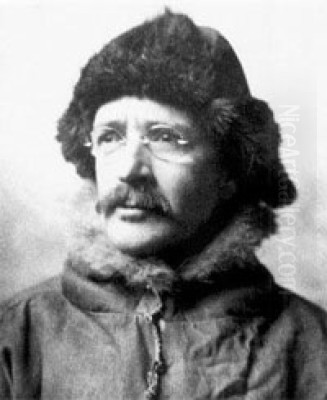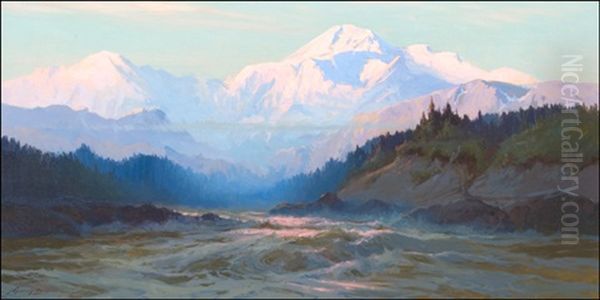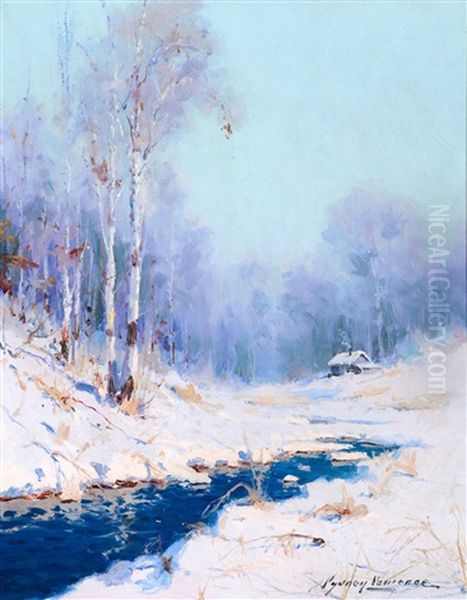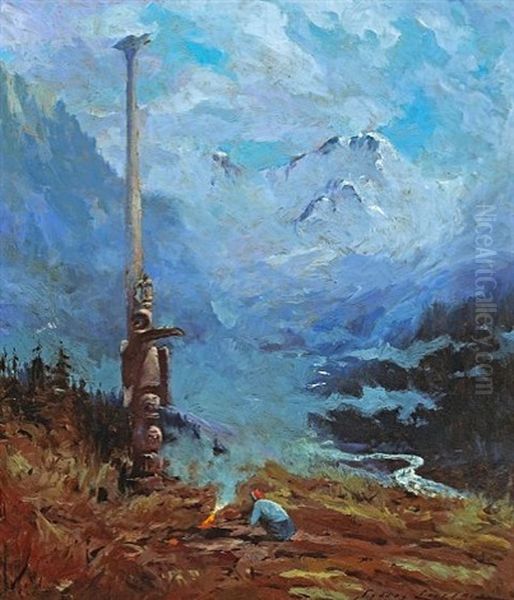
Sydney Mortimer Laurence stands as a pivotal figure in American art history, particularly renowned for his evocative and enduring depictions of Alaska. An American painter associated with the Romantic tradition, Laurence (1865-1940) dedicated much of his career to capturing the sublime beauty and rugged spirit of the Alaskan landscape, earning him the title of the territory's most significant historical artist. His work not only documented the visual splendor of the North but also played a crucial role in shaping the popular image of Alaska as "The Last Frontier."
Early Life and Artistic Formation
Born in Brooklyn, New York, in 1865, Sydney Laurence emerged from a background connected to both commerce and the arts. His father was involved in the insurance industry, while his mother was herself an artist, potentially providing an early creative influence. Laurence sought formal training in the vibrant artistic hub of New York City, enrolling at the prestigious Art Students League. This institution was a crucible for many American artists, fostering diverse talents and approaches throughout its history.
During his formative years in New York, Laurence found a significant mentor in the acclaimed marine painter Edward Moran. As reportedly Moran's first student, Laurence initially focused on seascapes and coastal scenes, mastering the techniques needed to depict water, light, and atmosphere – skills that would later prove invaluable in rendering the dramatic skies and waters of Alaska. Edward Moran, part of the famous Moran family of artists including his brother Thomas Moran known for his grand Western landscapes, provided Laurence with a strong foundation in traditional painting techniques.
European Sojourn and Broadening Horizons
In 1889, Laurence married Alexandrina Fredrika Dupre. Soon after, the couple relocated to England, settling in St. Ives, Cornwall. This coastal town was already becoming a notable artists' colony, attracting painters drawn to its picturesque scenery and unique maritime light. While living abroad, Laurence was exposed to European artistic currents. His time in St. Ives likely brought him into contact, or at least proximity, with artists associated with the St. Ives School, such as Stanhope Forbes and Walter Langley, who were known for their plein air techniques and depictions of local life.

Laurence actively pursued his professional career while in Europe. He exhibited his work with respected institutions, including the Royal Society of British Artists in London and the prestigious Paris Salon. Acceptance into these venues indicated a level of technical skill and artistic recognition that placed him within the broader transatlantic art scene of the late 19th and early 20th centuries. This period abroad broadened his artistic perspective before his eventual return to the United States and his fateful journey northward.
The Call of the North: Embracing Alaska
Around 1903 or 1904, Sydney Laurence made a life-altering decision to travel to Alaska. The exact reasons remain somewhat debated, possibly linked to the allure of gold rushes or simply a desire for adventure and new artistic subjects. Regardless of the initial motivation, he became deeply captivated by the territory. Significantly, Laurence is recognized as the first professionally trained artist to make Alaska his permanent home and primary subject matter.
His early years in Alaska were not solely dedicated to painting. He lived for a time near the village of Tyonek on the shores of Lake Clark in southwestern Alaska. Like many newcomers to the territory, he engaged in various pursuits, including prospecting for gold and working as a photographer. These experiences undoubtedly deepened his understanding of the land and its people. However, by 1911, Laurence began to focus more exclusively on his art, channeling his experiences and observations into his canvases. He eventually settled in Anchorage, which served as his base for roughly the last 25 years of his life.
Artistic Style: Romanticism, Tonalism, and the Alaskan Light
Sydney Laurence's mature style is best characterized as a form of American Romantic landscape painting, infused with elements drawn from various artistic movements. His work often exhibits the soft, atmospheric qualities associated with Tonalism, a style popular at the turn of the century championed by artists like George Inness, James McNeill Whistler, and Henry Ward Ranger. Tonalism emphasized mood, subtle color harmonies, and evocative light, often depicting scenes at dawn, dusk, or under hazy conditions.
Laurence skillfully blended Tonalist sensibilities with a strong sense of Realism, grounding his majestic scenes in careful observation of Alaskan geography and atmospheric conditions. There are also Impressionistic influences visible in his brushwork and handling of light, particularly in his attempts to capture the fleeting effects of Alaska's unique illumination, from the long summer twilights to the ethereal glow of the Aurora Borealis. He employed techniques like chiaroscuro (strong contrasts between light and dark) to add drama and depth to his compositions.

His artistic approach shows affinities with the earlier Hudson River School painters, particularly figures like Albert Bierstadt and his mentor's brother, Thomas Moran, who depicted the grandeur of the American West on epic canvases. Like them, Laurence aimed to convey the sublime power and awe-inspiring scale of the wilderness. He was also influenced by the French Barbizon School painters, such as Camille Corot, known for their commitment to painting landscapes directly from nature and their focus on atmospheric effects.
Iconic Subjects: Painting the Last Frontier
Alaska offered Laurence an inexhaustible supply of dramatic subjects. He became particularly famous for his numerous depictions of Mount McKinley (now Denali), North America's highest peak. His paintings of Denali, often viewed from vantage points emphasizing its towering majesty against dramatic skies, became iconic representations of the mountain and, by extension, of Alaska itself. One of his most celebrated works, Top of the Continent, featuring Denali, gained national recognition when it was exhibited at the Smithsonian Institution's National Gallery of Art.
Beyond Denali, Laurence's brush captured a wide array of Alaskan scenes. He painted the rugged coastlines and dramatic headlands of Cook Inlet, the serene beauty of the Susitna Valley, and the quiet intimacy of cabins nestled in the wilderness, sometimes illuminated by the Northern Lights. Marine subjects continued to appear, including sailing ships and steamships navigating Alaskan waters. He also documented aspects of human presence in the vast landscape, painting scenes featuring prospectors, Alaska Native settlements, and totem poles found in southeastern Alaska. Through these works, Laurence helped define the visual identity of Alaska, portraying it as a land of untamed beauty, immense scale, and romantic allure.
Later Life, Challenges, and Character
Laurence continued to paint actively throughout his later years, even after experiencing health setbacks. A stroke reportedly affected his coordination, leading to subtle changes in his painting style, yet he persevered. Anecdotes suggest he maintained a sense of optimism and humor despite these challenges. His resilience is highlighted by his positive attitude even as he approached his 75th birthday.
His personal life contained complexities. While his initial marriage was to Alexandrina Fredrika Dupre, later records indicate a subsequent marriage to Jeanne Kunath Holeman. Interestingly, although official records at the time of his death in 1940 listed him as a widower, evidence suggests Jeanne Kunath Holeman had actually divorced him prior to his passing. Another poignant anecdote involves his final contact with his first family; a Christmas postcard received from Alexandrina and their children in 1904 is sometimes cited as their last known communication, hinting at a separation perhaps precipitated by his move north.

Laurence's success and focus on particular subjects, especially Denali, did not come without criticism. Some contemporary commentators accused him of commercializing the Alaskan landscape, repeating popular compositions to meet market demand. One critic somewhat cynically referred to him as the "businessman who owned Mount McKinley," reflecting a tension between artistic creation and commercial success that many popular artists face.
A particularly striking anecdote surrounds his death. It is said that on the day before he passed away, Laurence visited his barber and remarked, "I am being dressed for death." This statement, whether factual or apocryphal, contributes to the mystique of the artist, suggesting a calm, perhaps even prescient, acceptance of his mortality.
Legacy and Market Presence
Despite any contemporary criticism, Sydney Laurence's legacy as Alaska's preeminent historical painter is secure. His works are foundational to the artistic representation of the state. He captured the essence of the Alaskan wilderness at a time when it was still largely remote and mysterious to the outside world, creating images that continue to resonate with viewers today. His paintings are held in numerous private collections and public institutions, most notably the Anchorage Museum, which holds a significant collection of his work.
The enduring appeal and historical importance of Laurence's paintings are reflected in their performance on the art market. His works frequently appear at auction houses across the United States. Notable sales have occurred at major venues like Christie's in New York, where works like Sailing Off Gloucester Coast have been sold. Specialized auctions focusing on Western and American art, such as the Coeur d'Alene Art Auction, have seen his paintings achieve significant prices, with reports of works fetching sums exceeding $200,000, confirming his status as a highly sought-after American artist. Even smaller auction houses, like Mroczek Brothers in Seattle, handle sales of his works, indicating a broad market interest.
Conclusion: The Artist of the Great Land

Sydney Mortimer Laurence occupies a unique and vital place in American art. He was more than just a landscape painter; he was an artistic pioneer who immersed himself in the Alaskan experience and translated its unparalleled grandeur, harshness, and beauty onto canvas. Influenced by Romanticism, Tonalism, and Impressionism, and mentored by figures like Edward Moran, he developed a distinctive style perfectly suited to his chosen subject. His depictions of Denali, the Northern Lights, and the vast Alaskan wilderness have become defining images of the region. Facing personal challenges and occasional criticism, he remained dedicated to his art, leaving behind a prolific body of work that continues to captivate audiences and solidify his reputation as the foremost painter of "The Great Land." His art remains a powerful testament to the enduring allure of the wild and the ability of a single artist to define the visual identity of a place.